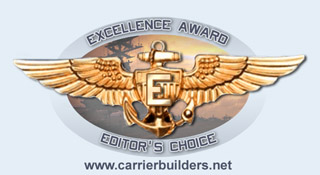
As this 3 part article
provides many useful information correcting fixing inaccuracies with
scratchbuilt
modifications on a stock model, and the build process is documented pretty
well both visually and text,
this model is awarded by Editor's Choice - Excellence Award!
Click here to see Part I.
Click here
to see Part II.

The model was primed with Surfacer 1000 thinned with lacquer thinner to check for surface flaws. Much to my dismay, the primer produced some severe orange peeling on the model, a problem I’ve never encountered previously with the brand. The issue was resolved after further thinning the primer and holding the airbrush a bit farther from the model. The orange peeling was sanded smooth and lost surface details restored. Once the surface preparations were complete, the exhausts were painted with Alclad II and the vertical stabilizers painted blue-black with a yellow trim. For some reason the custom mixed blue-black all but lost its subtle blue shade once applied to the model. The model was given a thorough flat black undercoat, a variation on pre-shading learned from hyperscale regular Steve St James. This method allows very subtle shade variations without the tendency of being too dramatic as pre-shadings often do. It is perfect for weathering and ‘livening’ up boring, monotone aircrafts, i.e. most modern jets. The model was then painted with FS 36320 and FS36375 for the top and bottom grey, respectively, with thinner than normal paint to take maximum effect of the black undercoat. Weathering was primarily done with randomly applied, heavily thinned artist’s oil paints comprised of arbitrarily mixes of black, white and raw sienna. This was concentrated largely to the upper fuselage/LEX area and the lower aft fuselage where foot prints contribute to the dirt and grind. Panel line wash was very restrained or unnecessary thanks largely to the initial black undercoat. Overall weathering was kept minimal as most Super Hornets don’t appear very dirty, particularly ‘Vampire 100’ and other land-based jets. The model was glossed coated with future prior to decal applications. The Superscale decal sheet went on beautifully, however it was plagued with colours issues with the insignia and stencil shades. The grey on these were supposed to be much lighter on ‘Vampire 100’ than typical line jets. A few light coats of heavily thinned down fuselage grey over the decals were necessary to tone them down..
The decals on the vertical tail had slight bleed through and the walk way on the left LEX tip was misshaped and needed correction. It was also over sprayed with a more appropriate colour. Remaining stencils were a mix and match with the kit decal sheet, which was rather comprehensive. A second future coat was given to the model after decaling before it was sealed with Gunze acrylic flat clear accentuated with a bit of Tamiya flat base.
A number of items still needed to be attached and finished after the model was out of the paint booth. The landing gears and gear doors were attached to allow the model to sit on its own legs. The main landing gears lack a solid, positive attachment, and plastic rods were used to build up where a significant gap existed between the leg support and the corresponding sidewall. The main landing gears were finicky, especially the door retraction arms. A number of items still needed to be attached and finished after the model was out of the paint booth. The landing gears and gear doors were attached to allow the model to sit on its own legs. The main landing gears lack a solid, positive attachment, and plastic rods were used to build up where a significant gap existed between the leg support and the corresponding sidewall. The main landing gears were finicky, especially the door retraction arms. Also attached at this point were the pylons and ordinances. The pitot static tubes and AOA sensor were scratch built from thin stretched sprue to give a more scaled look. The finished arresting hook was also attached onto the model. The ejection seat was inserted into the cockpit and the canopy and associating actuating mechanisms were attached in place. I also attempted to simulate the heat exchanger protective layers between the vertical stabs by building up with scrap decals, and then painted appropriately according to reference photos.
Lastly, scratch built intake and exhaust covers, as well as the RBF covers for the upper LEX boundary layer flow vents, were painted and affixed in place. The Remove Before Flight tags were taken from Eduard’s pre-painted photo etch set, which were brilliant except the paints chips when the RBF tags are bent.
I’m very glad to finally have built the Revell 1/48 Super Hornet. While it is definitely not up to their other recent offerings in terms of molding and detail fidelity or the easy of construction, it does have tremendous potential as a basis of a decent model at a very affordable price. Whether this is justifiable enough to for kit is up for grabs, but I can say that it has been one of the most challenging, edifying and definitely satisfying models I’ve had the opportunity to build. I would also like to take this time to thank the following individuals whose tremendous assistance on researching the Super Hornet, the Revell kit and ‘Vampire 100’ became indispensable through out this project: Mike Valdez, Dave Roof, Kurt Plummer, Larry McCarley, Ron Cline.
Click here to
see Part I. Photos © 2006 by John Chung July 22, 2006 |








































